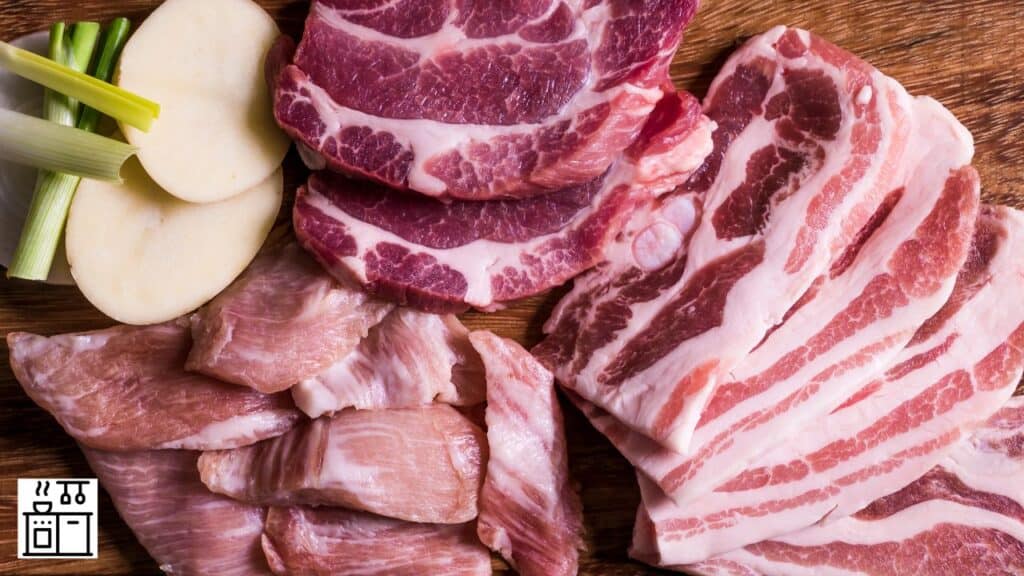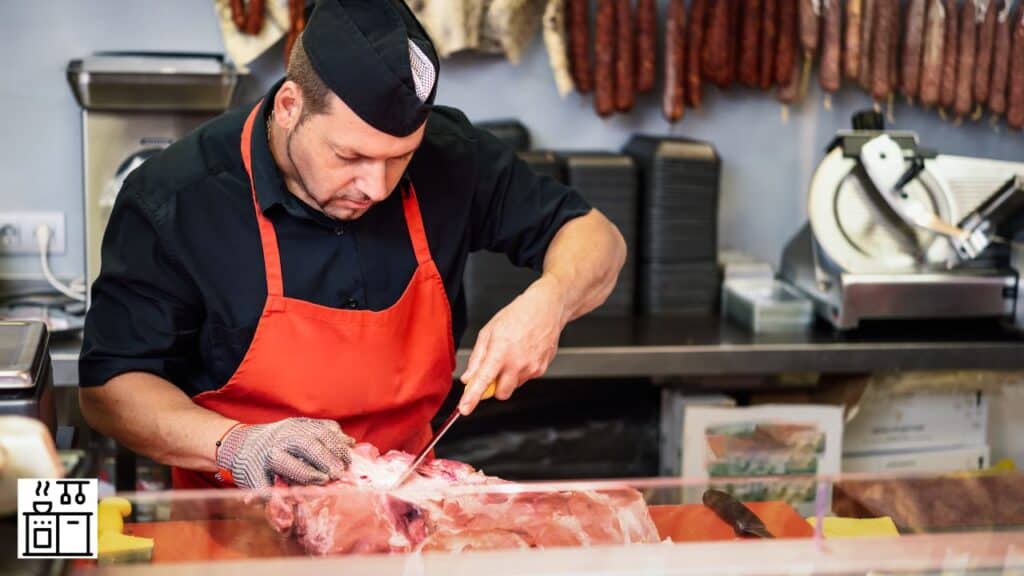There are several types of knives to cut meat. The boning knife is one of them.
These knives have thin, long blades with sharp tips.
This design allows the blade to penetrate the meat and make neat cuts.
So, they can slide near the bone and cut around the natural contours to separate the meat from the flesh.
Since boning knives are sharp and strong, they can easily cut through ligaments and connective tissue.
Butchers usually use this knife after they use the carving knife to make fine cuts in areas where the meat connects to the bone.
How to Identify a Boning Knife?
Boning knives are available in different shapes and sizes.
However, all boning knives share the following characteristics.
1. Slender Blade
The blade of a boning knife is narrower than other types of knives. It’s long and sleek, with a curved sharp edge.
The thin and slender shape and the sharp curved edge make it easy to push this knife through small spaces.
You can use it to remove skin or fat in a single swipe.
2. Straight Blade
Boning knives have a straight blade with a curved cutting edge. The straight blade makes it easy to sculpt meat.
You can easily push it into smaller joints to make neat cuts and lift the meat.
3. Flexible or Stiff Blade
The design of a boning knife will depend on what it’s used for. The blade may be flexible or stiff.
Flexible blades make it easy to cut around curved corners.
However, you can also find boning knives with stiff blades that can portion wide cuts of meat.
4. Reasonably Heavy
The boning knife is smaller than most knives in a traditional knife set.
However, good boning knives are reasonably heavy.
If it’s too light, it can slip and cause an accident.
The knife should be robust, and the blade should be properly attached to prevent accidents.
These factors are related to the shape and structure of the blade of a boning knife.
In addition, boning knives may also have different types of handles.
5. Handle Design
The handles of some boning knives have tiny holes.
They improve the grip of the knife and prevent the blade from slipping.
Meanwhile, the handles of some boning knives have grooves.
It creates a better grip and locks the knife in your palm.
In either case, the handle design helps to apply pressure on the meat or twist and turn the knife around tricky corners.
The handle of a boning knife may use metal or synthetic hard plastic. Both materials are food-safe and robust.
Older knives used wooden handles. But boning knives are typically used to cut meat.
Hence, it’s not recommended to buy knives with wooden handles.
Since wood is a natural material and it’s porous, it needs more cleaning and maintenance.
6 Top Uses of Boning Knives
The primary use of a boning knife is to cut meat. The shape makes it easy to work with tricky pieces of meat.
However, these knives are best for cutting around connective tissue.
Now, boning knives can be used for various other purposes besides cutting meat.
Let’s find out what they are.
1. Cutting Meat
Larger knives can easily cut tough cuts of meat.
However, their bulky blades can seldom work around tiny corners and bones where the meat attaches to the bone.
Boning knives are uniquely designed for carving fine cuts of meat.
You can use them for deboning, removing the skin, cutting connective tissue, and filleting fish or chicken.
The main benefit of this knife is that it makes neat and precise cuts and minimizes wastage.
2. Remove Fat from Meat

Many cuts of meat have fat on them. It’s difficult to remove fat without cutting into the meat.
However, a boning knife solves this problem.
You can gently push the thin and flexible blade of a boning knife between the fat and the meat.
Then, use the sharp edge to slice across the fat.
Since you have precise control over the cutting process, it’s easy to remove the fat without cutting any meat off.
You can also remove the thin and silvery film that coats certain cuts of meat with the boning knife.
3. Peeling Fruits and Vegetables
Boning knives have sharp and flexible or semi-flexible blades.
They are slender and long, making it easy to peel fruits and vegetables.
You can use these knives to remove the skin of fruits like apples and vegetables like cucumbers.
However, they may break if you apply too much pressure.
So avoid using it to cut the hard skin of pumpkins and pineapples.
4. Carving Baked Goods
You can score bread dough neatly with the sharp and thin blade of a boning knife.
This knife is also very useful for shaping and carving baked items like cakes and bread.
It’s easy to make neat incisions in the bread or cake without making it crumble.
So you can cut it into the desired shape for frosting and decoration.
5. Removing Corn Kernels
Boning knives make it easier to remove corn kernels from the cob.
Corn kernels usually attach tightly to the surface of a corn cob.
So you need a sharp blade to cut through it without waste.
The sharp and flexible blade of a boning knife easily moves into the gaps between the kernels and the cob and slices it without much damage.
6. Fillet Meat or Chicken
A traditional knife set usually has a fillet knife to cut fillets of meat and fish.
If you don’t have a fillet knife, you can use a boning knife to fillet fish and tender meat.
The main advantage of boning knives is that it doesn’t damage the meat.
You can cut tender pieces of meat like chicken and turkey with it.
The thin and sharp blade also makes it easy to cut fish without damaging it.
Further Reading:
Taking Care of Boning Knives
Good boning knives are built to last. Though the blade is slender and delicate, it holds up for a long time.
The design of the boning knife reduces drag. It helps the blade stay sharp for much longer.
However, the blade can lose its sharpness over time. It will then rip through meat and mess up the presentation.
Certain brands like Global makes boning knives with handles molded with the blade.
Some other brands may have a partial tang where the blade doesn’t extend into the handle area.
The construction material can also differ across brands.
Regardless of the tang and construction material, you can extend the lifespan of a boning knife with proper care and maintenance.
Simple steps like washing and drying the knife after use will help it last longer. Use soapy water to wash the knife.
Avoid placing it in the dishwasher since rough dishwashing cycles can dull the blade.
Over time, your boning knife will lose its sharpness.
However, you can sharpen it using a home knife sharpener or a professional knife sharpening service.
When sharpening the knife at home with a whetstone or other tool, be gentle since the blade can break if you apply too much pressure.

